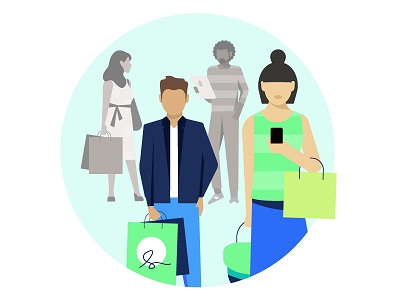An Intro to Retail Clienteling and Proactive Customer Engagement with CDPs
April 12, 2021Even as the world of retail and ecommerce becomes increasingly digital and data-driven, you need to maintain a human touch.
Whether you’re engaging customers in-store or online, clienteling tools and strategies can help you deliver personalized experiences that drive conversions. These personalized experiences are vital for strengthening customer relationships and boosting lifetime value in today’s hyper-competitive digital environment.
Historically, these personalized in-store experiences have been limited by sales associates’ lack of access to customer data. By using a Customer Data Platform (CDP) to create an enriched single view of the customer and democratizing access to that view across sales and service teams, you can give every team member the tools they need to become customer-centric, revenue-generating powerhouses.
Although clienteling is typically associated with in-store interactions, you can also use clienteling tools for proactive digital engagement with high-value customers as well.
In this blog, you’ll learn the answers to questions like:
- What is the definition of clienteling?
- Why is clienteling important?
- What are some examples of proactive clienteling in action?
- Which teams are responsible for effective clienteling?
- What should brands consider before implementing a clienteling strategy?
- What are some tips and best practices for clienteling?
What is clienteling and why is it important in retail?
Clienteling is a focused, proactive, and data-driven approach to improving the customer experience. By giving your sales associates the tools and insight to quickly access a detailed history of all omnichannel interactions for any customer, provide personalized recommendations, and collect key in-store data that’s currently lost, you can maximize sales and strengthen customer loyalty.
For example, a proactive clienteling tool might prompt your sales associates to deepen the conversation with a high-value customer with one of the following messages:
- “We’re including a little something just to say thanks….”
- “These would go great with the other products you bought….”
- “Your product is due for scheduled maintenance—here’s some information on next steps….”
- “Here’s a quick sneak peek before we release this product to everyone else….”
- “I noticed you purchase this product often. Would you like us to auto-send you this product every month?”
On the other hand, if your sales associate retrieves the profile of a relatively new or low-value customer, they might tailor their messages accordingly:
- “We’d love to get to know you better….”
- “Did you know you could do this with your product…?”
- “Here’s a little promo for your friends and family….”
- “Take a look at this new category we’ve launched….”
Regardless of the type of customer, each message is positioned to add special care and value to the recipient. Prompts like these, based on real customer data and predictive analytics, ensure that your sales associates never miss an opportunity to improve the customer experience.
By choosing a clienteling solution connected to a CDP, you can gain comprehensive insight into customer behaviors and preferences, enabling you to make better decisions about which actions to take during customer interactions. Plus, any data you collect during the clienteling experience is immediately unified with individual customer profiles within the CDP, filling gaps in customer insights and improving personalization efforts across the business.
Who’s responsible for clienteling?
Clienteling enhances both in-store and online engagement, so every team could benefit from it with the right tools and insights.
Along with retail sales associates, customer service team members can use clienteling tools for proactive outreach and engagement, transforming service from a cost-center to a profit-center. Although customer service teams have typically functioned from a state of reactivity, only interacting with customers after they’ve experienced an issue or submitted a ticket, clienteling technology gives customer service teams the ability to anticipate customer needs and seize opportunities to streamline the customer experience ahead of time.
Because CDP-powered clienteling technology allows sales associates to capture retail data and unify it to customer profiles, marketers can also use this additional retail data to improve personalization and re-target store visitors through digital channels.
What should you know before implementing a clienteling solution?
Successful clienteling requires the right tools, teams, and processes. Here are the 6 key questions you need to ask yourself before choosing a clienteling solution for your business.
- Who will need access to your clienteling solution?
- Which customers will you target and why?
- What should you say when you communicate with customers?
- How will you follow up with customers post-purchase?
- How will you measure the impact of clienteling activities and the performance of sales associates?
- How will you identify opportunities for change and optimization?
In other words, you need to spend time mapping out the ways in which different teams can use a clienteling solution, the relevant messages and recommendations you’ll configure for specific customer behaviors, the benchmarks and measurement strategies you’ll use to understand performance, and your plan for follow-up and improvement prior to the customer interaction.
This planning and consideration prior to implementing a CDP-powered clienteling solution will help you streamline the process and ensure consistency, quality, and efficiency across the board.
Our #1 tip for successful retail clienteling: Collect better data.
The biggest barrier to exceptional in-store personalization has always been a lack of data.
Collecting and accessing data in-store can be a challenge. Some brands lack the tools to do so, while others might have the tools, but the data collection step is consistently skipped during the sale. Additionally, brands might have a multitude of customer data from digital interactions but aren’t able to provide meaningful access of this data to sales associates.
Some CDPs and clienteling software like Lexer come with built-in data capture tools, so you can easily capture key relevant customer data in-store and immediately match that data with complete customer profiles within the CDP. When you combine this in-store customer data with online data and enrichment from third-party sources, strategic surveys, and predictive analytics, you can create a comprehensive view of the customer that gives you the most accurate insight into who your customers are and how best to engage them.
This unified, standardized, and enriched view is what enables you to configure the best possible recommendations for sales associates, maintain a consistent brand experience both online and offline, and easily track your performance over time to ensure you’re delivering exceptional service when and where it matters most.
Lexer’s CDP-powered retail clienteling solution provides you with comprehensive customer insight for improving the in-store experience, providing better service, and growing sales. With personalized product recommendations and next best actions based on predictive analytics, you can guide sales associates through interactions with each customer for consistently high-quality engagement.
A version of this article was originally published on Lexer.io with a focus in digital clienteling for proactive outreach and engagement. If you liked this, you’ll probably find more value in the original, in-depth version too. Click here to read the full version of “Clienteling: The Secret to Closing the Loop Between Brand and Buyer.”


